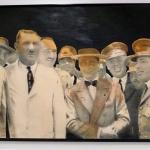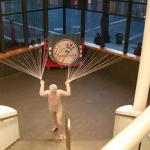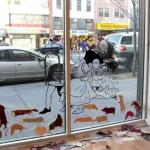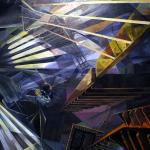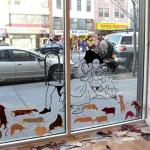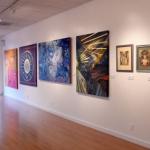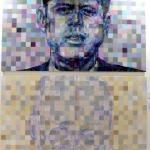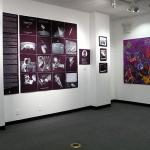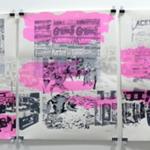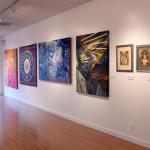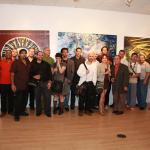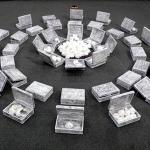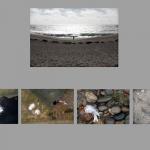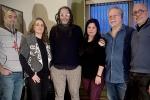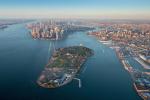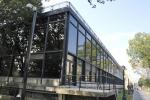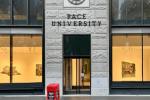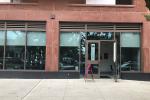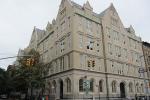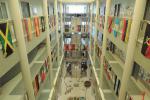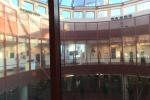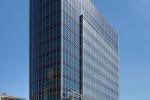In 2010, the Second Bronx Latin American Art Biennial "Exodus- 2nd Bronx Latin American Biennial" was presented. Although still a celebration of Latino culture, the exhibitions organized by curators Luis Stephenberg, Alexis Mendoza, and Miguel Lescano, became explicitly political in response to the charged national immigration debate.
Curator Luis Stephenberg said that "the migration and immigration that takes place in the United States right now is an issue that has to be analyzed through sociological and political analysis, not through discrimination."
The work by Hispanic artists from the United States and Latin American challenged the fear of immigrants that was stirred by recent developments nationwide, such as the statute enacted in Arizona in April 2010 requiring immigrants to possess documentation of their legal status at all times and allowing police to stop any individual they suspect of being in the country illegally.
Although not all of the art deals explicitly with immigration politics, several artists said that their work was informed by their experience of permanently leaving their countries or growing up as a minority in the United States.
The exodus process has become critical in Latin American countries and for a lot of Hispanics living in the United State this is the final frontier. This reality has dramatically revealed the inability of many governments to meet the growing needs in today’s society. The Bronx Latin American Biennial events aim to provide education and cultural information for every one as all the events are family oriented, free and open to the public. The Biennial celebrates not only the richness of Latin American art but also the diversity of our Bronx community.
“No Borders” presents artists who have a long term relationship with their subjects and who widely used different mediums to break down barriers of neighborhood, family, identity and class. These artists comment on ideas of separateness and merge into or comment on marginalized communities or individuals. Artists often choose to live in marginalized communities out of economic necessity and do not fit within a specific class structure but rather come from every background imaginable. They are drawn to life on the margins as it represents a distancing from the norm and allows for more freedom of thought and action.
In addition to performances at The Bronx Museum, the biennial included shows at the Gordon Parks Gallery, The Point and Lincoln Hospital. The program included several Art Exhibitions, throughout The Bronx, including The Point and the Bronx Museum. Artists addressed issues such as, migration and exile. This call for a rational and creative interpretation on the action of human migration presents particular perspectives that only art can achieve.
Artists included Adelia Sayeg, Arturo Parra, Bernardo Navarro, Eduardo Terranova, Gustavo Tavares, Hamlet Zurita, Hatjey Ramos Fermin, Angela Freiberger, Alicia Grullón, Josei Gonzalez, Jorge Mendoza, Moses Ross, Patricia Enrique, Raul Villareal, Sarosca, Sylvia Padilla, TATSCRU.
Art works in all genres and media representing 21 different countries were featured including urban installations, art performance, graffiti murals, videos, paintings, sculpture and graphics.
A performance at The Bronx Museum by Brazilian artist Angela Freiberger, CAGE FREE EGGS, explored the idea of ‘body’, in which the sculpture and other media suggest and become an extension of her. The sculptures represent and contrast the finitude of the human body. She incorporated performance art to challenge and transgress physical and mental boundaries.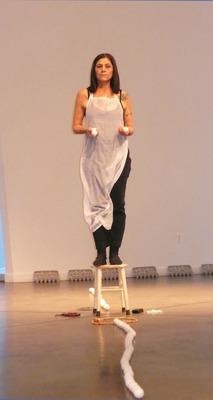
Alicia Grullón, in a performance at the Bronx Museum, lay motionless inside a messy lean-to made from scrap metal and fallen branches, Alicia Grullon seems to fade into the background even as spectators congregate to contemplate her unmoving, bloody body.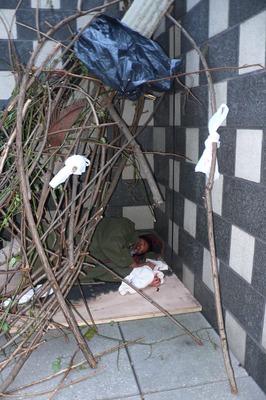
The performance depicts the death of an unidentified illegal immigrant who was found hiding in a wooded area on Long Island in 2007 — a problem Grullon contends happens regularly.
By highlighting the cultural contributions of Hispanics, the curators hope to build the self-esteem of the Latino community against the drain of social challenges, which range from adapting to a new culture to accessing better health, education and housing.
“The goal is to show the community what Hispanics can do for the Bronx,” said Alex Mendoza, another of the show’s curators. “We try to bring positive views of the community and show that [Hispanics] can do better than what we see on the news.”
In a review of the exhibition, art crtic Samuel Guzik explored the Biennial's themes. "The goal is to show the community what Hispanics can do for the Bronx,” said Alex Mendoza, another of the show’s curators. “We try to bring positive views of the community and show that [Hispanics] can do better than what we see on the news".
Curator Miguel Lescano, a Peruvian artist worked with artists from South America to solicit submissions for the Biennial.
To expand the show’s reach, the exhibition at the Gordon Parks Gallery was featured as a stop on the monthly Bronx Culture Trolley, a project of the Bronx Council on the Arts.
The Bronx Latin American Art show began in 2008, and included only three gallery spaces — The Bronx Museum, Lincoln Hospital and an exhibition space at Boricua College — and featured art on the theme of history and memory.
The following year, the group organized other programs to commemorate Hispanic culture, including a theater festival, music festival and street fair, Mendoza said.
The Bronx Hispanic Festival, a non-profit group made up of five volunteers, organizes the biennial.
The festival grew out of Lincoln Hospital’s commemoration of Puerto Rican history that began 20 years ago. As the Hispanic and Latino communities in the south Bronx grew, the festival expanded its focus to reflect the changing community.
“It is our responsibility to support the development of the Latino community,” said Stephenberg. “It’s not just because we want to do it: it’s because it’s our responsibility as Latinos.”

